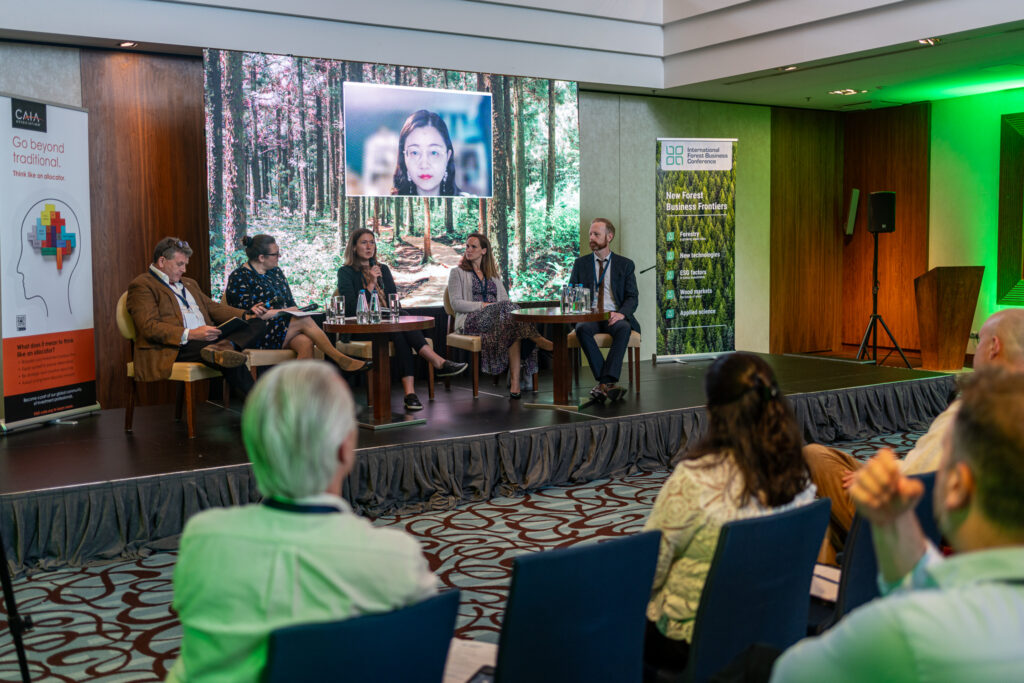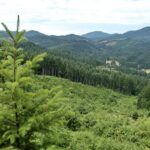Updates on emerging and traditional themes in forest finance
Last week I attended the International Forest Business Conference in Poland. We were a mix of mostly European and North American players in the forest sector. From the investment community to forest managers, sawmillers, consultants, tech providers, nature-based solutions project developers, academia and more. We really had the full range of players extending throughout the forest value chain – maybe only construction and other end markets were missing.
This week I’m taking stock on the key themes in forest investment as discussed at the event – new and old and my takeaways from this highly engaging event.

Evolution is apparent throughout forest value chains and investment
- Chinese wood markets: In a presentation from Margules Groome, we learned the details surrounding the growing Chinese wood market. China’s increasing wood demand is resulting in an increase in their own wood supply. However, due to low availability of suitable land for planted forests, China will continue to rely heavily on imports. Margules Groome also presented on how they support their clients with climate-related financial disclosures.
- Diversified wood products: In a presentation by The Price Companies, we learned the evolution of this highly diversified company. Particularly interesting was Price’s CEO’s perspectives on the dynamic wood basket in the US, where it is evolving to include products like textiles, and sustainable aviation fuels. Also noted was the tendency for populations to be moving out of traditional timber growing regions, and the need to speed up wood market development to provide employment opportunities.
- TIMOs in emerging markets: Unique presented on Timberland Investment Management activity in emerging markets, which they estimate to be home to 10-15% of global forest investment activity (54% in the US, 24% in Oceania, 9% in Latin America and 13% in other geographies). In their reflection on increasing emerging market appetite due to the emergence of carbon markets, they have found that $5/carbon credit increase can result in up to 1% IRR upside (depending on project features). Unique also presented eco-acoustics and camera trapping for biodiversity monitoring that they help their clients with.
Technology supporting the Forest Sector is emerging
- Technology and Compliance: The EU Deforestation Free Products Regulation, is set to come into force at the end of 2024. In answer to this, Deeplai has created a timber marking solution, that is not only a hammer stamp on logs to track them through the supply chain but enables tamper-proof log encryption coding and a log fingerprint signature so that the origin of wood products is undisputable.
- Technology and Fire Detection: Ororatech is providing the latest in forest fire detection, monitoring, and evaluation – where it serves governments, like the Province of Quebec in keeping a pulse on the wildfire situation. It provides real time data to decision-makers to help suppress fires early and help forest managers make decisions on where and how to allocate these often-limited resources.
- ESG integration in forest management software: Remsoft, a pioneer in forest management software has incorporated ESG into their forest management planning tool. Where elements such as ecosystem conservation, or optimizing a landscape for carbon sequestration can be built into the management regime and support managers in spatially and temporally planning for other forest values than timber.
- Carbon finance accessible to smallholders: TreeO is a digital tool that allows for the simplification of single tree measurements so that small hold farmers may participate in the voluntary carbon market through forestry and agroforestry programs on their farms. The platform is compliant with major certification standards’ methodological requirements, and supports the entire forest carbon value chain – from the farmer, to project developers and carbon credit buyers.
Innovation in biodiversity finance
- Biodiversity Offsets: Regardless of your instinctual reaction to the term offset, it would be hard to dispute the nature-positive impacts of Dasos’ first biodiversity positive renewable energy transaction. In this engagement, Dasos creates a net gain in biodiversity for a wind farm development in Finland. Through looking at different natural habitat features that will be negatively impacted through the farm’s development (3.5 hectares in total), Dasos will restore areas with the same habitat features (12ha) in its vicinity. This project is generating returns in line with timberland investment and has received no public funding.
- Digital biodiversity data collection: It was hard to decide whether to call this a technological solution or an innovation in biodiversity finance, as Collective Crunch’s platform is both. In joining the myriad of digital forestry tools, I found their approach to forest biodiversity identification innovative. The platform considers factors such as tree species, stand structure and the amount of deadwood to identify valuable biodiversity protection areas, and where biodiversity needs to be restored.
Carbon markets are awaiting the Carbon removals and carbon farming (CRCF) Regulation
- US dominates the EU in forest carbon projects: The EU has about 10x fewer carbon projects in the US, largely because the California cap-and-trade program and associated regulations (with other jurisdictions in North America following) was developed several years ago.
- The CRCF is coming and prices are high: In a much anticipated regulation for carbon market players in Europe, the CRCF is finally providing some much needed clarity through its regulations on how landowners in Europe can participate in various AFOLU improvements and sell credits in a quasi-compliance-voluntary market. Average prices are much higher than in the US, with conservative price estimates of $50/tonne.
Managed Forests are Resilient Forests
- The double benefit of Forest Insurance and good forest management: There were two forest asset insurers speaking at the event: Dual and ForestRE, and what became clear was that managed forests, with wildfire prevention measures, detection systems and suppression were the more resilient against wildfire. Both insurers iterated that as a forest asset owner seeking insurance (which covers primarily catastrophic fire and wind related loss), management should first and foremost have robust fire prevention and management programs. Without these, you will either not qualify for insurance, or have extremely high premiums.
- Investors need to evaluate asset location carefully: ForestRE also highlighted the importance of asset location. A map showed hurricane risk in the US southeast, within a certain distance to the coastline, where data was also provided on the damage to forest assets from hurricanes in the riskiest areas. Smart acquisition of assets in terms of avoiding investments near high risk (high likelihood, high severity) climatic events is the first and most critical safeguard.
Timberland is Evolving to Value Climate and Nature
I wanted to finish on the panel that I sat on, superbly moderated by CAIA, titled Mobilizing capital for forestry, climate and biodiversity conservation outcomes. On the panel we were a mix of private institutional timberland, represented by Nuveen Natural Capital and the International Woodland Company (IWC) and Development Finance Institutions, represented by FMO from the Netherlands and FinnFund from Finland, where I sat at the interface between the two. From the private side, Nuveen and IWC were promoting the traditional features that make timberland an attractive asset class for institutional investors, such as inflation hedging, and low correlation. On the development finance side, FMO and FinnFund were promoting the impact opportunities, associated with climate, biodiversity and people alongside the financial opportunities appreciated by investors. I called on traditional timberland investment managers to improve their sustainability credentials and investment product offerings that reflect (and capture) climate and nature values, as was showcased also by Nuveen and IWC.
If you are an investment manager on a journey toward profitable and impactful forest investment, and would like support to understand how to best integrate nature and climate objectives into your offerings, please reach out so we can build your momentum in the evolution of the forestry asset class.
I support timberland investment managers to increase their sustainability credentials efficiently – so you can capture more climate and nature value in the assets you manage and attract the investors who are looking for it. Learn more about my Timberland Upgrade service and set up a call to see if its right for you.
Did you like this article? Sign up now for the ForestLink’s newsletter, where you’ll receive technical advice, reflections, and best-practice guidance to support you with your forest-linked investment strategy or business straight to your inbox.





